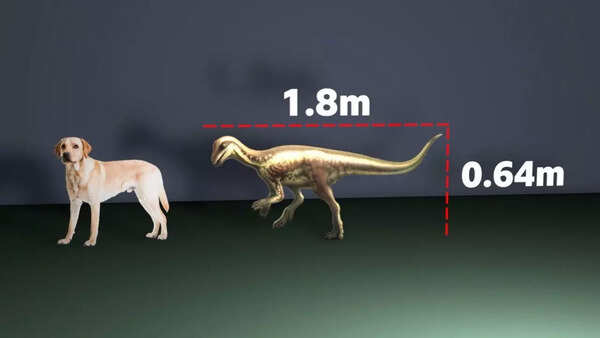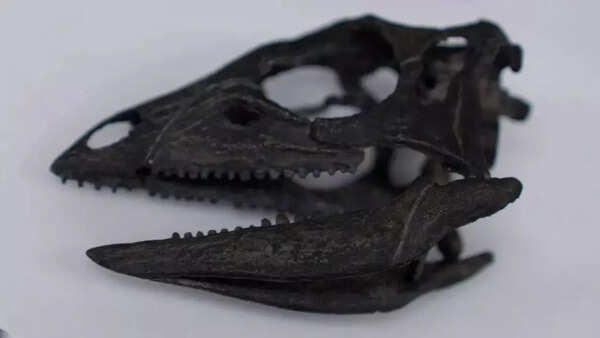Scientists have announced the discovery of a new, diminutive dinosaur species, roughly the size of a modern dog, that once roamed the Earth alongside some of the largest dinosaurs ever to exist. This remarkable find offers valuable insights into the biodiversity of prehistoric ecosystems and how smaller dinosaurs managed to thrive in the shadow of giants.

A study published in Royal Society Open Science details the identification of Enigmacursor mollyborthwickae, a dinosaur approximately the size of a Labrador retriever, with its tail accounting for half of its total length. Initially misclassified as a Nanosaurus, further examination led scientists to recognize it as a distinct species. The fossil is currently exhibited at the Natural History Museum (NHM).
The name Enigmacursor, meaning "puzzling runner," alludes to the challenges faced in classifying this unique creature. This relatively small dinosaur stood about 64 cm tall and measured 180 cm in length, comparable to a Labrador. However, it possessed distinctive features such as larger feet and a long tail. It lived approximately 150 million years ago, coexisting with iconic dinosaurs like Stegosaurus.

The classification of the species proved difficult. Researchers visited the US to analyze the original Nanosaurus specimen. However, they discovered that the specimen was incomplete, consisting only of a rock with bone impressions, rendering definitive identification impossible.
Despite its small size, this dinosaur played a significant role in its ecosystem, scurrying around the feet of enormous herbivorous and carnivorous dinosaurs. The discovery sheds light on how smaller species adapted to survive alongside massive contemporaries, revealing a complex prehistoric environment.

This groundbreaking discovery significantly enhances our understanding of dinosaur diversity, evolution, and behavior. It challenges the assumption that only larger dinosaurs dominated these ecosystems, providing evidence that smaller species played crucial roles. This finding contributes valuable data for investigating evolutionary relationships across vast geological timescales.
Newer articles
Older articles
 Rishabh Pant's Game-Changing Innings Draw Adam Gilchrist Comparisons, Says Greg Chappell
Rishabh Pant's Game-Changing Innings Draw Adam Gilchrist Comparisons, Says Greg Chappell
 Greg Chappell: Rishabh Pant's Explosive Batting Redefining Cricket
Greg Chappell: Rishabh Pant's Explosive Batting Redefining Cricket
 Birmingham Nets Offer Clues: Bumrah's Intent and Kuldeep's Drive Ahead of Second Test
Birmingham Nets Offer Clues: Bumrah's Intent and Kuldeep's Drive Ahead of Second Test
 Gavaskar Calls for Kuldeep Yadav's Inclusion in Second Test Following India's Defeat Against England
Gavaskar Calls for Kuldeep Yadav's Inclusion in Second Test Following India's Defeat Against England
 Bollywood's "Swades" Anthem Joins Axiom-4 Mission, Fueling Indian Astronaut's Space Journey
Bollywood's "Swades" Anthem Joins Axiom-4 Mission, Fueling Indian Astronaut's Space Journey
 Stokes Lauds England's Openers for Setting Up Thrilling Chase Against India
Stokes Lauds England's Openers for Setting Up Thrilling Chase Against India
 Rogue Star Threat: Earth's Solar System Stability at Risk, New Study Warns
Rogue Star Threat: Earth's Solar System Stability at Risk, New Study Warns
 Bangladesh's Shadman Islam Defends Batting Lineup After Day 1 Setbacks Against Sri Lanka
Bangladesh's Shadman Islam Defends Batting Lineup After Day 1 Setbacks Against Sri Lanka
 Mirabai Chanu Reveals Relentless Focus on Training, Weight, and Sacrifices Required for Elite Weightlifting
Mirabai Chanu Reveals Relentless Focus on Training, Weight, and Sacrifices Required for Elite Weightlifting
 India Aims to Rewrite History in Birmingham Test After Headingley Setback
India Aims to Rewrite History in Birmingham Test After Headingley Setback